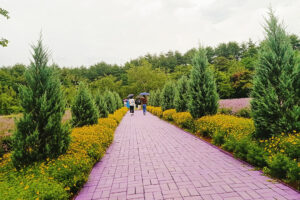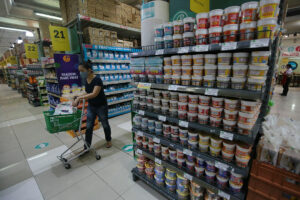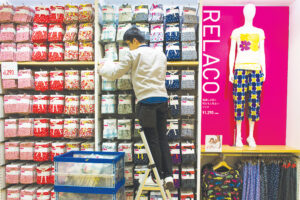A visa-free trip to the South Korean countryside

By Michelle Anne P. Soliman, Reporter
WHEN the COVID-19 pandemic led to the closure of international borders, fans of all things Korean turned to watching Korean dramas, learning to cook the dishes featured in scenes from their favorite Korean series and films, and watching Korean singers perform in virtual concerts.
Now that countries are opening up, travel is once again possible, and those interested in going to the land of K-pop finally can. And, depending on where they are going, they don’t even need a visa.
Visitors entering Korea via the Yangyang airport with accredited tour operators can do so visa-free (https://overseas.mofa.go.kr/ph-en/brd/m_3275/view.do?seq=760897&page=1).
The Yangyang International Airport serves as the gateway to the province of Gangwon. The South Korean low-cost airline Fly Gangwon offers direct flights from Clark Airport in the Philippines to Yangyang Airport in Gangwon, Korea.
“We all know that securing a visa is one of the deciding factors of tourists when deciding their next travel destination. Introducing visa-free travel this year is one way to overcome the obstacle,” Korean Tourism Board Assistant Manager Bhea Iwarat told BusinessWorld in an e-mail.
Visa-free entry for Filipinos through Gangwon Province began in 2018, during Pyeongchang Winter Olympics. “[The visa-free trips] were supposed to return at the start of 2020, until the pandemic happened,” Ms. Iwarat said.
“One unique point we would like to highlight regarding Filipino tourists is that traveling with family members are very common….,” she said. “As the popularity of Korean culture, and travel continue to grow, we would like to tap into that market so we could encourage every Filipino family to spend their holidays in Korea.”
Data from the Korean embassy in the Philippines recorded 516,503 Filipino visitors to South Korea in 2019. Data about Filipino visitors since the opening of international travel between both countries after the pandemic lockdowns ended has yet to be determined.
(https://www.mofa.go.kr/eng/nation/m_4902/view.do?seq=27).
GANGWON, SOUTH KOREAThe province of Gangwon is located the east side of the Korean Peninsula — an hour and a half drive from Seoul. The province has seven cities, 11 counties, and a population of 1.56 million.
During the winter, Gangwon is popular for its numerous ski resorts. But during the summer, its top tourist spots are its beaches and coastlines.
During a three-day weekend to Gangwon back in June, we visited the cities of Sokcho, Goseong, PyeongChang, and Gangneung.
PLACES TO EXPLOREThe trip’s first stop was the Naksana Temple in Yangyang. It was built by Ui-Sang, the ambassador of the 30th King of Silla Period (57 B.C. to 935 A.D).
While walking in the temple’s vicinity one sees various assemblages of stacked stones. Our tour guide said that stacking a stone on top of another is commonly done when making a wish.
At the end of an uphill trek is the 16-meter white granite statue of Avalokiteshvara Bodhisattva (the Goddess of Mercy) and a breathtaking view of the East Sea.
BEACHES AND THE BTS BUS STOPYangyang Surffy Beach is (as one can glean from its name) a place for surfers and students of the water sport. The beach has a separate zone for surfers and swimmers. While we did not go for a swim, we did lounge at the bar and restaurant where guests can enjoy food, drinks, and music. It also has souvenir shops and a camping area.
The second beach we visited is Sockho Beach which is nearer to commercial establishments. One also finds the Sokcho Eye, a 65-meter Ferris wheel, at the beachfront. The ride has 36 passenger cars that can hold six people each. The top of the Ferris wheel offers an expansive view of the beach and the Seorrakan Mountain.
Another beach to visit is Yeongjin Beach, located in Juminjin which is one of the filming locations of the popular K-drama, Guardian: The Lonely and Great God (2016). Near the Juminjin Breakwater is the “BTS Bus Stop” where the famous Korean boy band shot the photographs for You Never Walk Alone (2017), a repackage of their second studio album, Wings (2016). Note that the BTS Bus Stop is not an actual bus stop, but a recreated photo zone for visitors and fans.
HANI LAVENDER FARMIt was a rainy morning on the way to the Hani Lavender Farm in Goseong. After a 30-minute drive from the hotel, we noticed that the asphalt on the way to the farm was, appropriately, painted purple.
Hani Lavender Farm was founded in 2006 by Ha Deok-ho. Mr. Ha moved from Gyeonggi province where he used to operate an herb shop, to Goseong to cultivate his lavender farm.
Aside from lavender, the picturesque 33,000 sq.m. farm is also planted to crops such as rye and chamomile. The farm also has a souvenir shop with products made with lavender such as herbal tea, soap, lotion, and essential oils.
The farm is a lovely place to take photos. However, the continuous rains made that a challenge on the day of our visit.
During the summer, the areas of Eochin-ri in Goseong-gun are covered with purple blooming lavender fields. Every June, the Lavender Festival is celebrated for three weeks.
MARKET AND RESORTA trip would not be complete without a stop to buy gifts and try Korean street food. One good place to visit is the Sockcho Jungang market, a traditional market which opened in 1980. Each alley designated for various products such as seafood, chicken, vegetable, and fruits.
Another stop on our tour was found at the foot of Balwangsan Mountain. The Yongpyong Resort is a popular ski resort in Pyeongchang which also served as the venue for skiing events during the 2018 Winter Olympics. The country’s first ski resort, it opened in 1975. In the winter, it sees an annual average snowfall of 250 centimeters. The ski resort was also the filming location for the Korean drama Winter Sonata (2002).
Since it was summer during our visit, we instead went for a Mt. Balwangsan Cable Car tour, which stretches over 7.4 kilometers. At the end of the cable car tour is a skywalk at a Swiss-style building called Dragon’s Peak.
Tourists can also visit the skywalk via an elevator in the Dragon’s Peak building or climb 136 steps to reach it. According to information painted on the steps, climbing 136 steps burns a total of 34 calories.
ARTE MUSEUMImmersive media art can be found at the Arte Museum. The museum is inside what used to be a speaker manufacturing company. The 4,600 sq.m. space is filled with digital art, colorful 10-meter-tall installations of lights and sounds. Each room flashes a variety of images including beaches, thunder and lightning, forest, waterfalls, a garden, and geometry.
Navigating the museum can be tricky as the space is very dim with the images on the walls as the only light source. It is also surrounded by tall mirrors and glass partitions.
After wandering through the museum, guests can enjoy refreshments at the Arte Tea Bar, where even the milk tea is artistic. We were served the best-seller, Strawberry Moon, a cold milk tea. Once it arrives, the table’s sensor is activated and shows an image of an artwork of blooming pink flowers surrounding the glass. A portion of the artwork is also reflected inside the glass. As one drinks, the artwork around the glass also shrinks, and it disappears when the beverage is fully consumed.
At t exit of the Tea Bar is a souvenir shop with products such as scented candles, bags, gadget accessories, art, and decorative materials.
BEACH, COFFEE, AND A WOODEN HOUSEAt the front of Gangneung Anmok Beach is a stretch of coffee shops. During the trip, we were all allotted an hour to choose a coffee shop. I chose a place called Bossa Nova due to its industrial design and an al fresco second floor overlooking the beach.
There I enjoyed a cup of Ethiopian brew, and a surprising find (since there was no label on the pastry): a semla, a Swedish Lenten bun. The coffee shop also sold packed croissant-shaped treats for dogs.
The Ojukheon Complex gets its name from the robust black bamboo trees that surround it. One of the oldest residential and wooden buildings in Korea, the Ojukheon house is the maternal family home of Shin Saimdang, a Korean artist, writer, calligraphist, and poet of the Joseon period. The house is Treasure No. 165 on Korea’s list of cultural heritage.
Shin Saimdang’s image is seen on the Korean 50,000 won bank note. She is considered the best female artist of the Joseon Dynasty and a role model of a good wife and mother. Meanwhile, Yi L, her son who was born in the Ojukheon house, became a noted politician and scholar. His image is found on the 5,000 won bank note.
TRAVEL REQUIREMENTSHealth requirements to enter Korea have been eased considerably. There is no required vaccination level for international passengers and negative COVID-19 test results are no longer required.
According to the Korean Tourism Board’s website, the requirement for a post-entry PCR test within one day upon entry to Korea was lifted on Oct. 1, while the pre-entry negative PCR test result requirement was lifted in early September. (http://english.visitkorea.or.kr/enu/AKR/FU_EN_15.jsp?cid=2862555&fbclid=IwAR0wTvm1OqREmdrer04N0PoetT2fMtYE2mwJE1tfWWDKBRx5kGjULkWCmgE).
But to travel visa-free, one has to book a tour through a travel agency.
“[The] visa-free entry through Yangyang is only possible through booking group tours from designated travel agencies by the Korean Embassy, and their partners. One group must be five or more in number and must travel together at all times,” the Korean Tourist Board’s Ms. Iwarat said. (https://overseas.mofa.go.kr/ph-en/index.do).
Prior to the flight back to the Philippines, tourists are to accomplish the One Health Pass (https://www.onehealthpass.com.ph/) to be filled up on the same day as their date of arrival.
BusinessWorld traveled as a guest of the Korean Tourism Board (KTO).




